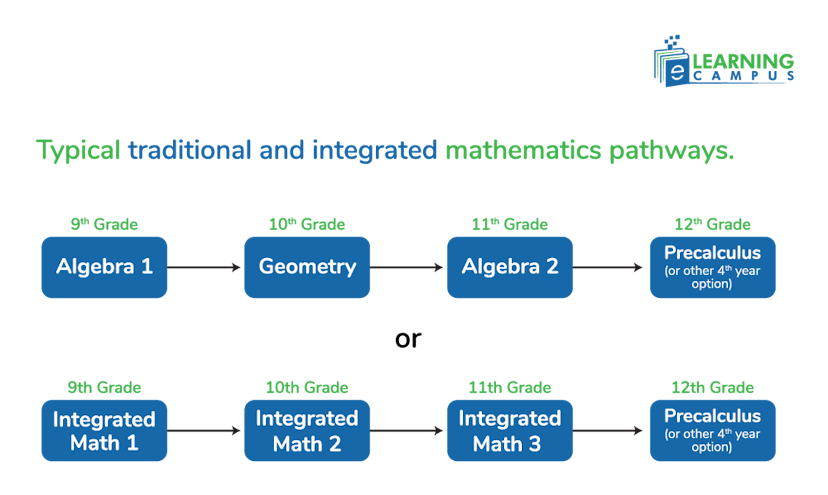What is Integrated Mathematics

We have been learning math since our childhood, but have you ever heard of the term integrated mathematics? It may be a new concept for students who follow the traditional math curriculum. It is a method of teaching mathematics that combines multiple branches of math.
Integrated mathematics is a modern approach to learning that blends topics like algebra, geometry, trigonometry, and statistics into one cohesive program, helping students to build a deeper understanding and stronger concepts.
In this guide, we provide a deep knowledge of what integrated mathematics is. How is it different from traditional math? Why it matters and how this technique is beneficial for students.
What is Integrated Math?
The word integrated means combined or connected. Integrated mathematics is a modern teaching method that combines different branches of math like algebra, geometry, trigonometry, and statistics rather than teaching them separately.
For example, a student studying geometric shapes might also apply algebraic formulas or use statistical reasoning to find the solution to a problem.
It blends the mathematical ideas to build stronger connections. Instead of learning these subjects separately, students study them together to understand how math works in real life.
Integrated math aims to :
- Break down barriers between math fields.
- Prompts conceptual understanding instead of memorization
- Encouraged critical thinking by relating topics.
- Prepare students for real-life applications where multiple math skills are often used together.
Why do Many High Schools Use Integrated Math?
Many high schools use integrated methods because they offer a more connected and practical way for students to learn mathematics. This approach combines subjects such as mathematics, statistics, algebra, and geometry into one program to build stronger concepts and qualities that are essential for their career.
Many high schools around the world, specifically in the U.S, Japan, and parts of Europe, have adopted integrated Math programs instead of traditional math sequences.
Traditionally, methods of learning math are:
- Algebra I
- Geometry
- Algebra II
But Integrated Math combines these subjects into three levels: Integrated Math 1, Integrated Math 2, and Integrated Math 3. Their focus is to build connections between topics so students can think critically and apply math to diverse fields, and be able to link the formulas to practical life.
Levels of Integrated Math
Many high schools now use integrated math programs instead of traditional algebra I, Geometry, and algebra II. The curriculum is usually divided into three levels:
- Integrated Math 1
- Integrated Math 2
- Integrated Math 3

What is Integrated Math 1
Integrated Math 1 is the first course in the integrated mathematics curriculum, often taught in 9th grade. It combines the basic concepts from algebra, geometry, and statistics into one connected learning program to build the basic concepts of these topics.
Integrated Math 1 connects different areas of math, so students can :
- See how algebra and geometry work together
- Strengthen analytical and reasoning skills
- Prepare for integrated Math 2 and future advanced studies.
- Understand how math works in daily life.
Main Topic in Integrated Math 1
- Linear equations and inequalities
- Graphing and interpreting
- Coordinate geometry
- Geometric transformations
- Statistical reasoning (Mean, median, and data plot)
Why is Integrated Math 1 important?
Importance of integrated math 1:
- Build a foundation in algebra, geometry, and functions
- Develop logical and problem-solving skills
- Prepares you for integrated math 2 and 3
- Strengthen understanding of graphs, equations, and reasoning.
What is Integrated Math 2
Integrated Math 2 provides a connection between algebra, geometry, and trigonometry more deeply. It challenges students to analyze complex mathematical relationships and solve multi-step problems. You will explore patterns, shapes, data, and equations.
Main Topics in Integrated Math 2
- Quadratic functions and their graphs
- Systems of equations
- Right-triangle trigonometry
- Congruence and similarity in triangles
- Probability and compound events
- Data modeling
Why Integrated Math 2 is Important
The importance of Integrated Math 2 is:
- It builds a connection between algebraic and geometric reasoning
- It strengthens logical thinking through proof and trigonometry
- It prepares students for Integrated Math 3, where there is advanced learning
- It improves problem-solving and data interpretation skills needed in science, business, and technology fields.
Integrated Math 3
Integrated Math 3 is the final stage, focusing on advanced algebra, trigonometric concepts, exponential functions, and data analysis.
Main Topics in Integrated Math 3
- Exponential and logarithmic functions
- Polynomial functions and complex numbers
- Trigonometric Identities and Laws
- Advanced geometry
- Statistical interference and data modeling
Why Integrated Math 3 is Important
The importance of integrated math 3 is:
- It combines all topics from Math 1 and Math 2.
- Focuses on advanced algebra, trigonometry, and statistics
- Improves analytical and modeling skills
- Helps apply math to real-world and data-based problems.
Benefits of Integrated Maths
Integrated math offers a modern technique of learning. It merges the subject, e, algebra, geometry, or statistics. It links the topics with one another and also shows how they are related in real life.
Here are the top benefits of studying integrated maths.
Greater Engagement and Motivation
One of the main advantages of integrated mathematics is that it keeps students actively involved and motivated to learn. By connecting lessons to real-life situations such as budgeting, architecture, sports, statistics, or technology, my students find math more meaningful and relevant to their everyday experiences.
Builds Conceptual Understanding
Students often struggle to memorize formulas, which is why they experience significant stress during exams or tests. Integrated maths helps them to understand why the formulas work and how topics are linked, which helps them to not only memorize the formulas but also build conceptual understanding. By seeing connections between algebra, geometry, and statistics, they understand how one concept supports another.
Encourages Problem-solving Skills.
Integrated math helps students develop strong problem-solving abilities by encouraging them to use multiple strategies, for example, designing or analyzing data. Students learn how to apply mathematical concepts creatively to find effective solutions. Integrated math builds that kind of flexible thinking.
Promotes Long-term Retention
Integrated mathematics helps students remember the concepts for the long term. Since topics are revisited every year deeper form, students retain what they have learned instead of forgetting after exams.
Encourages Collaboration in an Application
Integrated math often uses inquiry-based learning and group projects, helping students discuss, reason, and justify their solutions collaboratively. Many integrated math classrooms use group projects, technology tools, and hands-on activities to make math interactive and practical.
Challenges of Integrated Math
Like any educational reform, integrated math has its challenges.
- In the beginning, students find it hard to adapt because they have a habit of learning math with the traditional method.
- Integrated math is a newly adopted method. So, textbooks, worksheets, and online tutorials are harder to find compared to traditional math material.
- Parents familiar with traditional math may struggle to support their children with integrated lessons.
- Standardized tests often follow traditional categories, making it challenging to measure integrated learning fairly.
- Switching between topics can feel confusing early on.
- Some teachers trained in the traditional structure may find it hard to adapt to integrated approaches that require connecting multiple topics with flexibility.
Is Integrated Math Easier or Harder than Traditional Math?
Integrated math is neither easier nor harder than the traditional method. It's just a different way of learning mathematics.
- Some students actually find it more interesting because they can see how topics are linked with each other.
- In traditional math, you study Algebra 1, then geometry, then Algebra 2, each as a separate subject, but in integrated math, you learn a combination of these topics every year.
For Example, algebra, geometry, and statistics concepts are added into one course.
- This approach can actually make math more connected and meaningful. You see how shapes, equations, and data all relate to real-world problems.
- Some students find integrated math more engaging and logical because it helps them understand how one idea leads to another.
Conclusions
Integrated math is not a much harder version of math; it's just a smarter way to learn mathematics. In integrated maths, you learn algebra, geometry, and statistics in one program curriculum and see how they work together. This technique helps students to learn maths more quickly and remember it for the long term.
